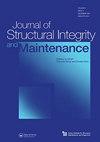Diagnosis of durability-related problems in concrete structures through comprehensive analysis and non-destructive testing: a case study
IF 3.1
Q2 ENGINEERING, CIVIL
Journal of Structural Integrity and Maintenance
Pub Date : 2023-07-10
DOI:10.1080/24705314.2023.2233812
引用次数: 0
Abstract
ABSTRACT The present study investigated concrete durability problems at the National University of Sciences and Technology,Pakistan, through comprehensive analysis and non-destructive testing. During the visual inspection of concrete structures, different deterioration mechanisms such as alkali-silica aggregate reaction (ASR), carbonation, abrasion and drying shrinkage were found. After visual inspection, the data on ingredients used in the construction of various structures were collected, revealingthat different brands of cement used in construction contained high alkali-equivalent content. Fine aggregates were used from two different quarries during construction. The available literature and X-ray Diffraction (XRD) results showed that both the quarries’ aggregates have the potential for alkali-silica reactivity. Furthermore, the XRD results of gel-type material collected from mapped cracking indicated the presence of delhayelite, similar to alkali-silica gel, suggesting ASR. The XRD curves of the whitest powder collected from various sites showed the presence of sodium sulfate and calcium carbonate peaks, indicating salt hydration attacks. The carbonation rate in concrete ranges from 4.33 to 5.77 mm/year. The results of the rebound hammer and pulse velocity test indicated that concrete used in parking has low strength which is the main cause of abrasion. Based on these findings a few recommendations have been presented to avoid durability-related problems in future structures.通过综合分析和无损检测诊断混凝土结构耐久性相关问题:一个案例研究
本文章由计算机程序翻译,如有差异,请以英文原文为准。
求助全文
约1分钟内获得全文
求助全文
来源期刊

Journal of Structural Integrity and Maintenance
ENGINEERING, CIVIL-
CiteScore
3.90
自引率
9.50%
发文量
24
 求助内容:
求助内容: 应助结果提醒方式:
应助结果提醒方式:


